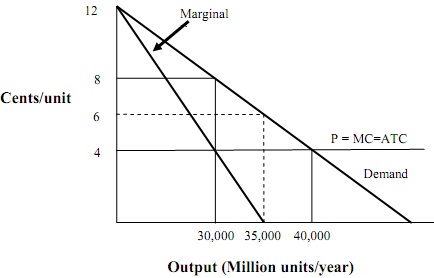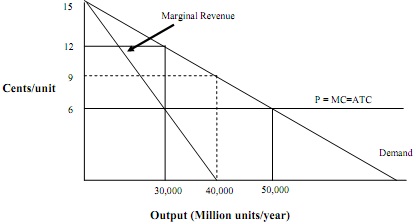Reference no: EM131241059
PROPOSAL A
Financial
Proposal A envisages generation of electricity from water - a hydro-electric project. The useful economic life of this project is estimated to be 60 years. This project will generate 50,000 million (mn) units of electricity annually. Electricity will be sold to the public at a tariff of 10 cents per unit. The annual operation and maintenance costs are expected to be 2.5 percent of the capital cost.
Economic (Social)
The economic (social) costs and benefits for this project must be estimated from Figure 1.
PROPOSAL B
Financial
Proposal B is a thermal project - electricity will be generated from coal. The annual operating costs for this project are estimated to be 5 percent of the capital cost. This project will also have a useful economic life of 60 years. It will generate 50,000mn units of electricity annually. The electricity from this project will be sold at 12 cents per unit.
Economic (Social)
The economic (social) costs and benefits for this project can be estimated from Figure 2.
Task
Your task is simply to summarize (in your own hand) the results of your analysis in the answer-sheet provided separately.
Notes:
- You must provide the background details (i.e., select calculations), for various answers provided by you in the answer-sheet, in an Annexure (no more than one double-sided page). You must type-write your Annexure. You must not attach any computer-generated spread-sheets in the Annexure. The minimum permissible font size for the Annexure is 12 (Times Roman or equivalent).
- The completed answer-sheet must however be a stand-alone document (i.e., the reader should be able to understand the entire logic behind your reasoning without needing to refer to the Annexure. You must however provide (in the annexure) background calculations for the reasoning provided by you for each question in the answer-sheet.
- There is no tolerance on specified word/page limits. Any written material beyond these limits will not be marked.
- Please tick only one box wherever a multiple choice is provided.
Assumptions (common to both proposals)
- All capital costs are incurred at time t=0 (i.e., ignore project construction time).
- Electricity generated, electricity tariffs, annual costs and the discount rate remain constant throughout the economic lives of the projects.
- The economic (social) costs and benefits must be estimated exclusively from Figures 1 and 2. The costs and benefits represented in these figures are all inclusive, i.e., total costs include capital and operating costs and the demand curves reflect of all benefits provided by the projects.
- For the purpose of estimation of economic (social) costs and benefits assume that the market structure for electricity sector is currently monopoly. It is expected to remain so for the first ten years of the project life-span. The government however proposes to transform this market initially into an oligopoly (for the years 11 to
30) and eventually competitive (years 31-60). While it is difficult to precisely estimate the price and quantity outcomes that will prevail in an oligopoly market, the economic brains of the time have suggested that these outcomes are as shown by dotted lines in Figures 1 and 2.
- The real and apparent annual discount rates are 10 and 15 percent, respectively. Further, the economic and financial discount rates can be assumed to be the same.

Figure 1 Economic (Social) Costs and Prices: Proposal A

Figure 2 Economic (Social) Costs and Prices: Proposal B
Figures 1 and 2 are Not-to-scale. Therefore, do not use these figures to estimate various areas. You should instead use values on X and Y axes to estimate various areas.49003 ECONOMIC
Please summarize your results in the table below:
|
|
Financial
|
Economic
|
|
|
Proposal A
|
Proposal B
|
Proposal A
|
Proposal B
|
|
NPV
|
|
|
|
|
|
IRR
|
|
|
|
|
|
PB
|
|
|
|
|
|
B/C
|
|
|
|
|
|
Equivalent Annual Cost
|
|
|
|
|
|
Consumer Surplus
|
|
|
|
|
|
Producer Surplus
|
|
|
|
|
|
Total Surplus
|
|
|
|
|
Note: NPV; Equivalent Annual Cost; Consumer, Producer, and Total Surplus - must be rounded off to the nearest billion dollars (i.e., no decimals), and IRR and PB - to the nearest ‘whole' percent and years (i.e., no decimals), and B/C - to one decimal point, respectively.
1. Which proposal will you recommend from the consumer's perspective?
Why? Because
2. Which proposal will you recommend from the economy's perspective?
Why? Because
3. Will your recommendation, based on economic perspective, change if, due to technological malfunctioning, the useful life of proposal B gets reduced to 30 years?
4. Is there a co-relation between your estimates of Life Cycle Cost and Equivalent Annual Cost?
5. In Figure 2, the oligopoly price is 9 cents per unit. Will the response of demand to price decrease from 9 to 6 cents per unit be elastic or inelastic?
6. From economic perspective, what is the price elasticity of supply for Project B when the price of electricity increases from 6 cents per unit to 9 cents per unit (Figure 2). Assume market for electricity is competitive?
7. Prices are generally higher in oligopoly and monopoly markets as compared with those in competitive markets. This results in loss of welfare (deadweight loss). In order to improve welfare, the governments therefore either offer direct subsidies to the oligopoly and monopoly firms, or allow the firms to price-discriminate. Assume that the government has allowed the oligopoly and monopoly firms to price discriminate. For proposal A, what is the total value of subsidy (expressed in present value terms) that the government will need to offer to the oligopoly and monopoly firms, in order to encourage them to produce at competitive market levels of production?
Please present your calculations (or explanation)? (in no more than two steps)
8. Sensitivity analysis can be used to determine how the viability of a project is influenced by over- or under-estimation of various input variables. Assume that Total surplus is used as the criterion for assessing the viability of Project B. What is the ‘switching value' of ‘capital cost' for this project?
Please present your calculations? (in no more than two steps)